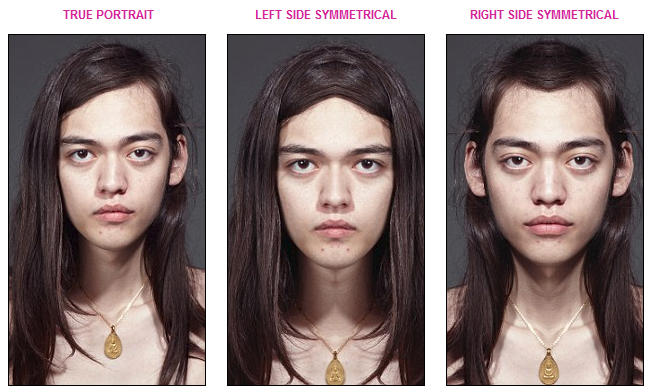
It has long been thought that the key to a “beautiful” face was symmetry.
The idea has always been that the human-eye subconsciously looks for symmetry, and faces with the most symmetrical features are considered the most desirable. (Some theorize that symmetry is a marker for overall health, and since you want to mate with someone that will give your offspring the best possible genetic makeup, facial symmetry is a sort of litmus test; akin to a peacock’s feathers.)
A skeptical photographer however, decided to test this theory.
Australia-based photographer Julian Wolkenstein took portraits of people, and then divided their faces into two halves. He then took each half and spliced it together with it’s mate, creating 2x new symmetrical faces.? If the “symmetry = beauty” rule was true, both symmetrical faces should be more beautiful than the original, right?

As Julian explains, the experiment was “overwhelming, and [highlighted] the differences big and small between peoples’ left and right sides.”
His ‘Symmetrical Portraits’ series used photographs of men and women of different ethnic backgrounds, and revealed wildly-varying differences in facial symmetry.
“Part of my project has been to de-bunk the myth that symmetrical people are better-looking. Some of the symmetrical faces don’t look attractive at all.” he admits.

Julian’s photographic symmetry project is part of his research into how people view one another.
Interested by people’s faces for years, Julian has long considered each individual face to be a piece of art.
“Faces are such a point of contact for us, they are the first thing we see in the mirror and they are the first thing that we see when we meet another person,” explained the artist.

Interestingly, Julian believes that the differences in the each side of the face may uncover secrets about how the brain works.
“It is interesting to see which side is more taunt and [which side] is more used, because that indicates which side of your brain might be more dominant,” explained Julian.
Julian goes on to describe his findings: “It is also interesting to see that some people look nothing like themselves when the two left sides are joined into one, or the right sides, or both. There is something about the joined left and right images that our own brains tells us is the same person, but at the same time it can make you feel uneasy. You realize something is not quite right.”

What do you think based on these images? Is symmetry actually beautiful, or is it each person’s unique features in total that add up to “beautiful”?
